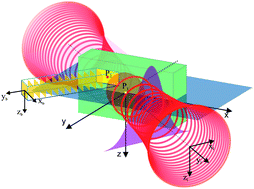Quantitative analysis in confocal micro-PIXE—general concept and layered materials
Abstract
In a typical micro-PIXE set-up the insertion of an X-ray optic such as a polycapillary half lens, in front of the X-ray detector in combination with the focused charged particle micro-beam creates a confocal geometry and thus a probing-volume. By moving the sample across the probing-volume, spatially resolved characteristic X-ray intensities are detected. The aim of this work is to present a theoretical model that describes the micro-PIXE intensities in confocal geometry in the case of either layered-structured materials or materials composed of major–minor elements exhibiting concentration gradients within depth. The influence of various experimental parameters such as the beam energy, spatial resolution of the X-ray lens, micro-beam dimensions, irradiation and detection angles, as well as the structure (thickness, composition) of the individual layers that compose the analyzed sample, is investigated by means of simulations of the PIXE yield at various positions of the analyzed sample within the probing volume. The advantages and limitations of the micro-PIXE analysis in confocal geometry are presented through examples and discussed, in particular with respect to the differential PIXE analysis.


 Please wait while we load your content...
Please wait while we load your content...